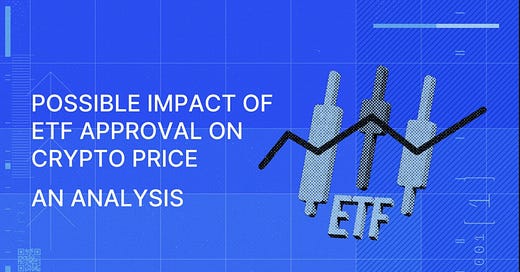Crypto investors are abuzz with the anticipation of the impact of ETF’s, stablecoins, and a pro crypto administration. The cryptocurrency market has undergone significant transformations over the past decade, evolving from a niche financial experiment to a global asset class. With the introduction of Exchange-Traded Funds (ETFs), the emergence of stablecoins like RLUSD for Ripple’s XRP Ledger, and the potential for a pro-crypto administration under Donald Trump, the landscape of digital assets is poised for further evolution.
This essay explores the impact of these developments on major cryptocurrencies such as XRP, XLM, and ETH, while also examining the broader implications for the crypto market.
The big question in the room these days is what about the rise of the crypto ETF’s and their impact on the crypto economy. Exchange-Traded Funds (ETFs) are investment vehicles that track the performance of an underlying asset or group of assets. Think in terms of a mutual fund in the world of stock trading. In the context of cryptocurrencies, crypto ETFs allow investors to gain exposure to digital assets without directly owning or managing them. These funds are traded on traditional stock exchanges, making them accessible to a broader audience, including institutional investors and retail traders.
Crypto heads are excited about the pro crypto teams the new administration is putting together in Washington D.C. The approval of Bitcoin ETFs in the United States, such as the ProShares Bitcoin Strategy ETF, marked a significant milestone for the crypto industry. By 2024, Ethereum ETFs also gained traction, further legitimizing the market. These ETFs provide a regulated and secure way for investors to participate in the crypto economy, reducing the barriers to entry.
Impact on XRP, XLM, and ETH
The introduction of ETFs has had a profound impact on major cryptocurrencies with previous releases. There is a lot of anticipation of the impact will be on XRP, XLM, XDC and ETH.
Increased Institutional Adoption:
ETFs attract institutional investors who were previously hesitant to invest in cryptocurrencies due to regulatory concerns and custody issues. This influx of institutional capital benefits established cryptocurrencies like Ethereum (ETH), which already have robust ecosystems.
XRP and XLM, which focus on cross-border payments and financial inclusion, may also see increased adoption as institutions recognize their utility in global finance.
Market Liquidity and Stability:
ETFs enhance market liquidity by providing a steady flow of capital into the crypto market. This increased liquidity can reduce price volatility, making assets like XRP, XLM, and ETH more attractive to risk-averse investors.
Price Appreciation:
The demand generated by ETFs can drive up the prices of underlying assets. For example, Bitcoin experienced significant price surges following the approval of its first ETF. A similar trend could occur for Ethereum and other cryptocurrencies included in future ETFs.
Competition Among Cryptocurrencies:
While ETFs benefit the overall market, they also intensify competition among cryptocurrencies. Assets with strong use cases and adoption, such as ETH, are likely to thrive, while others may struggle to maintain relevance.
The Emergence of XRP Stablecoin and Its Implications
What Is the XRP Stablecoin?
Ripple, the company behind XRP, has been exploring the development of a stablecoin built on the XRP Ledger and launched RLUSD on December 17, 2024. Unlike traditional cryptocurrencies, stablecoins are pegged to a stable asset, such as the US dollar, to minimize price volatility. The XRP stablecoin aims to combine the benefits of stability with the speed and efficiency of the XRP Ledger.
Use Cases and Adoption
The XRP stablecoin has the potential to revolutionize several industries:
Cross-Border Payments:
Ripple has already established itself as a leader in cross-border payments, partnering with financial institutions worldwide. The XRP stablecoin could further streamline these transactions by providing a stable medium of exchange.
Decentralized Finance (DeFi):
Stablecoins are a cornerstone of the DeFi ecosystem, enabling lending, borrowing, and trading without the need for traditional banks. The XRP stablecoin could expand Ripple's presence in the DeFi space, competing with Ethereum-based stablecoins like USDC and DAI.
Central Bank Digital Currencies (CBDCs):
Ripple has been actively collaborating with central banks to develop CBDCs. The XRP stablecoin could serve as a bridge currency, facilitating interoperability between different CBDCs.
Impact on XRP, XLM, and ETH
The introduction of the XRP stablecoin could have far-reaching implications. ETF’s will do their mark, but what will the impact of stablecoins be on XRP, XLM, ETH and others?
Keep reading with a 7-day free trial
Subscribe to "SMOKE & MIRRORS...XRP and the art of Critical Thinking" to keep reading this post and get 7 days of free access to the full post archives.






